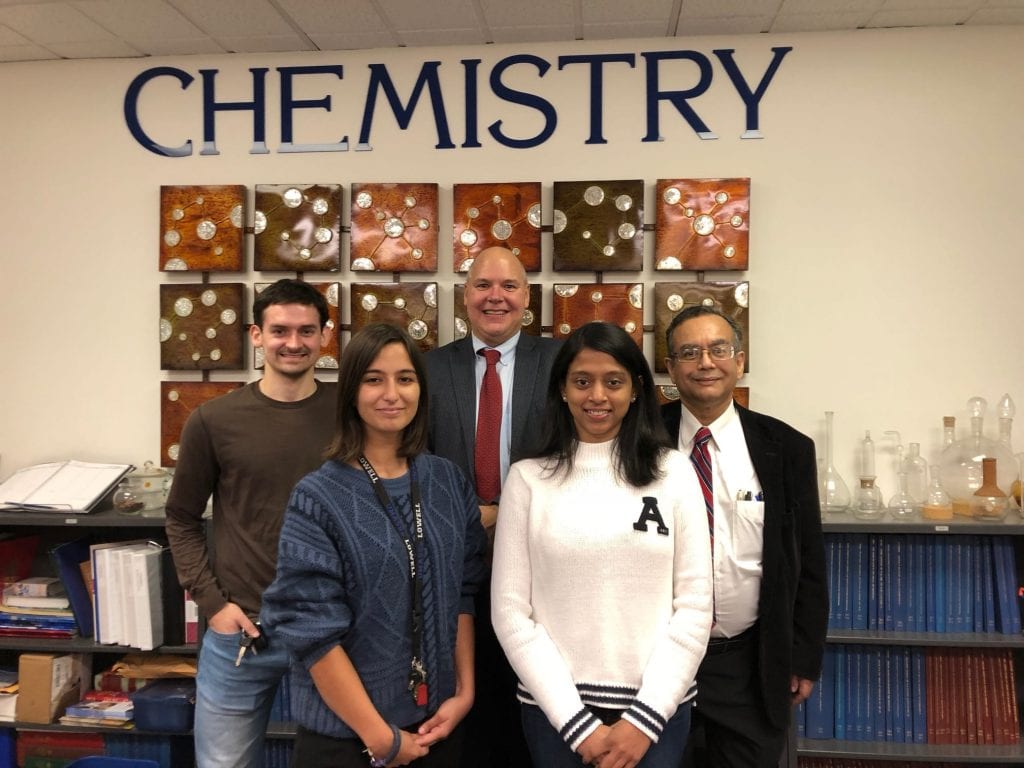

The Whitten group is performing research related to metal deposition on conjugated polymers and self-assembled monolayers (SAMs). Applications of this work include organic electronics. For example, details of the interface between conjugated polymers and metals (used as electrodes) may affect the efficiencies of light-emitting diodes, photovoltaic devices, and field-effect transistors since electrons and holes must be injected into and out of the organic layer. Surface science techniques that we use can measure both the chemical and electronic interaction between a metal overlayer and an organic film. Other projects include research to study what happens when a metal or another organic layer is deposited on top of self-assembled alkanethiols. This also has relevance in organic electronics, since SAMs may be used to tune the work function of electrode materials onto which conjugated polymers and oligomers are deposited.
Recent work in our laboratory has shown that a variety of materials, including block copolymers, proteins and derivatized conjugated oligomers may be patterned using a template approach. The method consists of using either microcontact printing or dip-pen nanolithography to form patterns of a self-assembled monolayer (usually an alkanethiol adsorbed on gold) that has a hydrophilic tail group. The rest of the surface is “backfilled” with a different self-assembled monolayer that is hydrophobic. When a predominately hydrophilic molecule (e.g., a block copolymer consisting of a majority of hydrophilic blocks) is spin-coated onto this substrate, the spin-coated material mimics the hydrophilic SAM pattern. In some cases, annealing in needed to cause diffusion of the spin-coated materials and development of the pattern. This research has applications in nanomanufacturing in which it is desirable to form nanoscale polymer patterns and in microelectronics.
Work is in progress in our laboratory to measure the forces between two surfaces as a function of distance. Motivated by nanomanufacturing needs, we are using the functionalized tip of an atomic force microscope (AFM) as one surface and a functionalized gold or silicon surface as the other. Research is being carried out to functionalize the surfaces with different alkanethiols or silanes such that strong, long-range attraction is achieved. It is also desirable to measure the forces needed to separate the surfaces after they have come together and to determine the reproducibility of the entire “jump-in, pull-off” cycle.
When gold nanoparticles are grown in the presence of alkanethiols, gold particles that are covered on their periphery with the alkanethiol can be synthesized. If the synthesis is carried out such that the diameter of the gold particles is ca. 10 nm, films of these may be used for chemical vapor sensing. First discovered by Hank Wohltjen and Arthur Snow at the Naval Research Laboratory, the gold particle films change their electrical resistance when exposed to organic vapor because of swelling of the films (and increased interparticle distance) due to vapor sorption. What is most remarkable is that the process is rapid and reversible. Furthermore, by using alkanethiols with different chemical functionality, selectivity can be achieved. We recently synthesized thiophene-terminated alkanethiols of different lengths and compared their sensing properties with respect to various organic vapors. This project is ongoing, and methods of forming nanoscale sensors are being explored.
The Whitten group is a leader in the use of ultraviolet photoelectron spectroscopy (UPS) to study conjugated polymers. This technique is particularly valuable with respect to conjugated polymer and oligomer films, since it permits direct measurement of the ionization energies of the highest occupied molecular orbitals (HOMOs). Additionally, by measuring the width of the UPS spectrum, the ionization energy or work function of the polymer film can be calculated. We have applied this technique to a variety of conjugated polymer/oligomer systems, including oligothiophenes, to study how the energies of the HOMOs change as the molecule progresses from monomer to hexamer. Recent work (in collaboration with the Swager group at MIT) has measured the ionization energy of conjugated polymer films used as fluorescence sensors for explosives.
